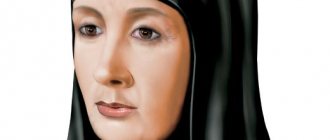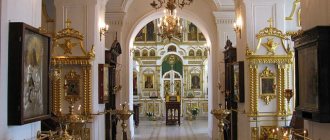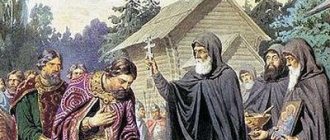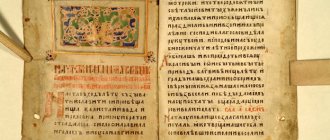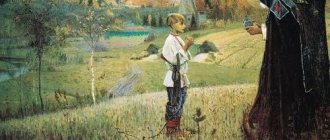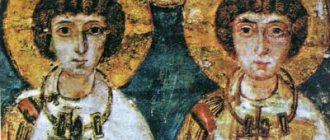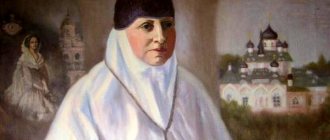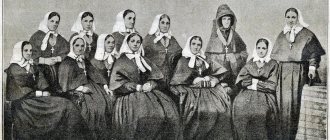Life of the Venerable
In 1353, a daughter was born into the family of Prince Dmitry of Suzdal and his wife Anna. This happened in the midst of an internecine war between the Moscow and Suzdal-Nizhny Novgorod principalities. The latter was quite large, but did not have actual status and could not rule Russia, so it fought for a long time with the Moscow rulers for independence status, not to mention primacy. However, the birth of his daughter gave Dmitry Konstantinovich hope for the further unification of the two territories. And so it happened.
Saints Prince Dmitry Donskoy and Evdokia of Moscow
Raised in the Orthodox faith and receiving a good education, at the age of 13 Evdokia became the wife of Moscow Prince Dmitry; the spouses at that time were 13 and 15 years old, respectively. The wedding took place in Kolomna, and the newlyweds were married by the Venerable Saint Alexy. Despite the fact that this marriage was an agreed upon and political decision (a guarantee for peace between the Suzdal and Moscow principalities), it lasted for 22 long years and gave the couple 12 children.
After the wedding, Prince Dmitry Konstantinovich of Suzdal became a loyal ally and partner of Dmitry Donskoy. Having united, the former rivals began to jointly resist external threats - the Tatar Horde and the Principality of Lithuania, which constantly encroached on the territory of Rus'. In addition to constant external threats, Rus' suffered from an epidemic - people died on the streets, livestock died from illness or hunger.
In addition, there was a huge fire in the capital - the city at that time was made entirely of wood, so it burned out quickly and on a large scale. In 1368, the Lithuanian ruler Olgerd besieged Moscow, which was burning again and only through the efforts of Russian soldiers was it possible to recapture the city.
More about the holy princes:
- Prince Dovmont of Pskov
- Life of the Holy Princes Boris and Gleb
- Icon of Saint Prince Vladimir
Even then, the princess showed herself as a merciful ruler - she helped orphans, arranged the fate of fire victims and widows. She constantly prayed for the fate of Rus' and Moscow, in particular.
Five years after the wedding, Prince Dmitry gathered in the Horde so that the khan would resolve his conflict with Prince Mikhail of Tver about rule. The wife constantly prayed for her husband and, at her request, God rewarded her - Prince Dmitry returned with a label to rule the grand duchy.
It is worth noting that Evdokia and her husband Dmitry always relied on the Lord; their confessor was the First Hierarch Alexy, the metropolitan of the capital, as well as his disciples St. Sergius and St. Feodor.
It was they who blessed Dmitry Donskoy for his campaigns and battles, instructed the couple and prayed for them. The Monk Sergius baptized Prince Dmitry and his first-born Vasily. Thanks to constant mentoring, Donskoy’s wife strengthened her faith and was a reliable support for her husband.
Wars
In 1380, the couple faced a new separation - the fight with Mamai reached its climax, and Dmitry led his army to fight the Tatar-Mongols. The Monk Sergius predicted victory for the prince, but this did not reduce the princess’s worries about her husband - she spent all her time in her cell in prayer for the preservation of the life of the Grand Duke.
It was then that the great Battle of Kulikovo took place and, despite heavy losses, Prince Dmitry Donskoy retained the principality and freed himself from the yoke of Mamai. In honor of this event, the Princess of Moscow built the Church of the Nativity of the Virgin Mary right inside the Kremlin. The great Theophanes the Greek and Simeon the Black were invited to paint the church.
Church of the Nativity of the Virgin Mary of the Moscow Kremlin
However, peace did not reign in Moscow for long - in 1382, Khan Tokhtamysh began his campaign, and Dmitry Ivanovich was forced to gather an army again. Soon after his departure, Evdokia, along with his children and Metropolitan Cyprian, were forced to flee the capital after the prince, as there was a threat of capture of the city - the Tatars subsequently captured and burned Moscow.
A year after the burning of the capital, the princely family was forced to give their first-born Vasily to Khan Tokhtamysh as collateral for the payment of tribute. Son Vasily lived in captivity for two long years and only then managed to escape.
Grand Duke Dmitry died in the spring of 1389, transferring the right to rule to his son Vasily, but at the same time making his wife co-ruler. The widow experienced her husband’s departure extremely painfully; their marriage, concluded because of politics, degenerated into true and ardent love. The chronicler recorded the suffering of the princess, creating “The Grand Duchess’s Lament for her Dead Husband.”
Widowhood
Dmitry Donskoy wanted to prevent fraternal enmity between his children, so Evdokia became the guarantor of the transfer of power to the eldest son (in the event of his death to the next in age) - it was she who had to divide the inheritance between the sons. In addition, Dmitry transferred more than 30 volosts and 20 large villages to her ownership, while 15 and 14 of them, respectively, completely belonged to her, which made the widow economically and politically independent of her children.
Venerable Euphrosyne of Moscow
In fact, she did not rule the principality, although she could have done so. Power was given completely into the hands of Vasily, and Evdokia herself concentrated on serving God. According to eyewitness accounts, she wore chains under her dress every day, fasted and visited churches and monasteries every day. As a widow, she was not spared by people's rumors about her dissolute life, but they had no factual confirmation.
The widow of Dmitry Donskoy also helped prevent a war with Tamerlane - in 1395, the khan came close to the borders of Rus', and Prince Vasily gathered an army for battle. Evdokia advised him to move the miraculous icon of the Vladimir Mother of God for protection.
All this time, she and all the priests of Moscow fervently prayed to God for deliverance from the Tatar-Mongols, and the Lord performed a miracle - Tamerlane turned aside and left Rus'. According to some, at the very time when the icon was being greeted in Moscow, he had a dream - the “Lightning Woman” was surrounded by many “lightning-fast warriors” and it became the reason for his capitulation.
Monasticism
The children were already adults, so Evdokia began to think about monasticism, but first she decided to establish a new convent for women in Moscow - in the Kremlin she founded the Ascension Monastery right at the Florovsky Gate.
It was here that she saw off and met her husband from the campaign to the Kulikovo Field, and right there she built monastic cells. In 1407, the widow of Dmitry Donskoy took monastic vows and received a new name - Euphrosyne of Moscow.
Euphrosyne was not only a wise wife, but also a faithful Christian. Thanks to her efforts, a large number of churches and monasteries were built in Moscow and other cities. Among them:
- Ascension Convent (in the tree);
- Church of the Virgin Mary (in stone);
- Church of the Nativity;
- Goritsky Monastery in Pereyaslavl;
- Church of the Nativity of John the Baptist in Pereyaslavl.
Having accomplished numerous good deeds, remaining in the memory of Muscovites as a kind and faithful wife, as well as a merciful princess, Euphrosyne of Moscow died in May 1407 and was buried at the site where the Church of the Ascension of Christ was founded.
Prayers
Troparion, tone 8
Because of your earthly widowhood, you lost sight of the Heavenly Bridegroom/ and lived as an ascetic in the princely palace,/ after which you left both the palace and your children/ for God’s sake, Venerable Euphrosyne,/ and entered the monastery you created,/ and in a different manner you showed many deeds ,/ and by the grace of God you crowned your holy life with a blessed death./ And now those who stand before Christ God, // pray for our souls to be saved.
Troparion, tone 5
From your youth, chosen by God to be a saint, / leaving the bright palace of the prince, / you turned away to the monastery you created, / and, having swum through the abyss of the sea of life, / now with the Angels you sing hymns to Christ God. / Pray to Him unceasingly, venerable one, / for the monastery to remain preserved. , created by you, / and gives us peace and great mercy.
Quotes from the Holy Fathers for every day
Dear fathers, brothers and sisters!
viagra soft tabs viagra dosierung
argaiv1467
Please accept my heartfelt congratulations on your patronal holiday - one of the days in memory of the Venerable Euphrosyne, Grand Duchess of Moscow.
Following the example of the heavenly patroness of our temple, we will serve our neighbors with our good deeds, we will give people faith, hope, love and, of course, joy - after all, this is how the name of our holy mentor is translated from Greek.
Holy Grand Duchess Evdokia was born in 1353. She was the daughter of the Suzdal prince Dimitri Konstantinovich († 1383) and his wife Princess Anna. Raised in the spirit of Christian piety from infancy, Evdokia was distinguished by a quiet, meek disposition. But, living in Suzdal and Pereyaslavl-Zalessky, in a turbulent environment of constant internecine strife that the appanage princes waged with her father, from an early age Princess Evdokia became accustomed to placing all her trust in God. In 1367, she became the wife of the blessed Grand Duke of Moscow Dimitri Donskoy († 1389). Their happy union was the key to union and peace between the Moscow and Suzdal principalities. Princess Evdokia’s love for her husband and children was sanctified by her love for God. The princess and her husband combined works of Christian charity with feats of fasting and prayer. In their lives, they relied on the help of the saints, for whose works the Russian land was so glorious in those days.
The time of life of the holy blessed Grand Duchess Evdokia († 1407) coincides with the era of the great abbot of the Russian land, Venerable Sergius of Radonezh, the seer of the Holy Trinity. The pious couple can rightfully be considered disciples of St. Sergius. Saint Alexy, Metropolitan of Moscow, was close to the princely family; the confessor of Evdokia and Demetrius was the disciple of St. Sergius, abbot of the Simonov Monastery, St. Theodore (later Archbishop of Rostov). The Monk Sergius was the godfather of their two children (in total the princely couple had 8 sons and 4 daughters).
The princess's soul burned with great love for God, the Holy Church and the Motherland. The feat of Grand Duke Dimitri in liberating Rus' from the Mongol-Tatar yoke was shared by Princess Evdokia. The campaign of the noble Prince of Moscow Dimitri against Mamai, which ended victoriously on September 8, 1380 on the Kulikovo Field, was supported on her part by fervent prayers and deeds of love. In memory of the victory, the princess built a temple inside the Moscow Kremlin in honor of the Nativity of the Blessed Virgin Mary - the world-historical victory of the Russians on the Kulikovo Field took place on this holiday. The temple was painted by the outstanding icon painters Theophanes the Greek and Simeon the Black. The creation of temples and the founding of monasteries through the labors of the holy princess Evdokia contributed to the flourishing of Russian temple building in the 14th century, which began with the construction of a temple in honor of the Most Holy Trinity by St. Sergius.
Gradually, the life of the holy princess Evdokia became a feat of self-denial and surrender of oneself entirely to the will of God. In 1383, the Grand Duke of Moscow was supposed to appear before the Tatar Khan Tokhtamysh. But because of Tokhtamysh’s extreme anger towards Prince Dimitri, they decided to send his eldest son Vasily, who was about 13 years old at that time, to the Horde. Saint Eudokia released her son and thereby doomed herself to two years of suffering: Prince Vasily was detained in the Horde as a hostage. In 1389, the noble Prince Demetrius, not yet forty years old, fell dangerously ill and passed away to the Lord (May 19/June 1).
The widowed princess saw her duty to God primarily in completing the upbringing of her children. At the same time, she began the construction of the Ascension Convent in the Moscow Kremlin, giving the princely palaces for it. Apparently, she initially thought of this monastery as the place of her future monasticism. At the same time, she built several churches and monasteries in Pereyaslavl-Zalessky. However, Princess Evdokia did not only think about the construction of churches: her main secret goal after the death of her husband was the establishment of internal monasticism, the creation of a temple in her own heart. Princess Evdokia began to lead a secret ascetic life. Judging by the magnificent clothes in which the holy princess appeared before people, it was impossible to guess that she exhausted herself with fasting, vigil, and heavy chains. She also had to endure human slander.
After the blessed death of her husband, the holy princess abstained from direct participation in state affairs, but nevertheless, it was with her advice that the transfer of the miraculous icon of the Most Holy Theotokos from Vladimir to Moscow, caused by the invasion of Moscow by Khan Tamerlane, was connected. The Most Holy Theotokos responded to the popular prayer. On the day of the presentation of the icon in Moscow (August 26, 1395), Tamerlane had a menacing vision in a dream of the Light-Bearing Woman; the frightened conqueror retreated from Moscow. In 1407, after a vision of Archangel Michael, who foreshadowed her imminent death, Princess Evdokia, “detached from all earthly things by the appearance of an angel” (see akathist), decided to leave the Grand Duke’s mansion and accept monasticism, which she had been pursuing all her life. On her instructions, an image of the Archangel was painted and placed in the Kremlin church in honor of the Nativity of the Blessed Virgin Mary. During the transition to the Ascension Monastery, Princess Evdokia healed a blind man, who regained his sight by wiping his eyes with the edge of her robe, and 30 people were also healed from various ailments during this procession. At the monastery, the princess took monastic vows with the name Euphrosyne. In addition to the humble performance of monastic deeds, secret to people, but known to God, the holy princess founded a new named Church of the Ascension in the monastery. Saint Euphrosyne lived in monasticism for several months: on July 7, 1407, she peacefully reposed in the Lord. Her body was buried in the Ascension Monastery that she founded.
The holiness of St. Euphrosyne is certified by the miraculous signs of God's mercy that took place at her tomb for several centuries. Many times they saw that at the tomb of Saint Euphrosyne the candle itself was lit. And in the 19th century, several miraculous healings took place here. Thus, in 1869, after venerating the tomb with the relics of the saint, the possessed youth was healed. In 1870, the Monk Euphrosyne appeared in a dream to a paralyzed girl and restored her to health. A terminally ill man was brought back to life by placing on him a shroud from the tomb of St. Euphrosyne. Her spiritual feat testifies that neither wealth, nor high social position, nor family ties can be an insurmountable obstacle to the acquisition of God's grace and holiness.
https://azbyka.ru
